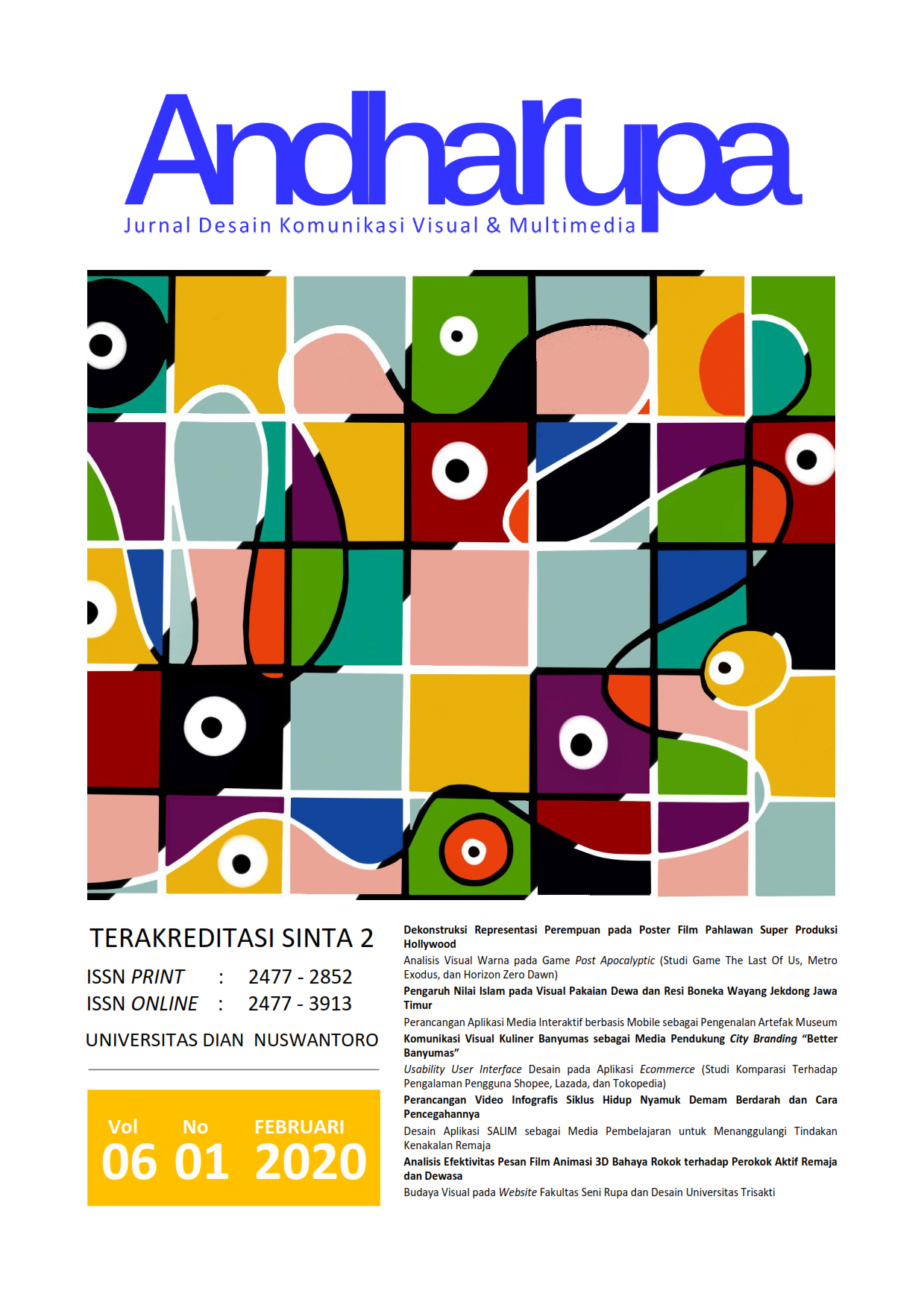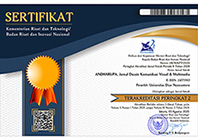Analisis Visual Warna pada Game Post Apocalyptic (Studi Game The Last Of Us, Metro Exodus, dan Horizon Zero Dawn)
DOI:
https://doi.org/10.33633/andharupa.v6i1.3232Abstract
AbstrakVideo game sebagai bentuk media visual di era modern memiliki peranan dalam masyarakat sebagai salah satu bentuk hiburan yang bersifat interaktif. Video game terus berkembang dalam tata visual sebagai bentuk evolusi dari teknologi video game tersebut. Evolusi dalam video game membuat genre dalam video game juga mengalami perkembangan. Salah satu genre yang menjadi tren adalah genre post apocalyptic. Penelitian ini mencoba melihat narasi yang hendak disampaikan lewat tata visual beberapa video game dengan genre post apocalyptic. Metode yang dilakukan adalah dengan mengumpulkan data screen capture dari beberapa judul video game dengan rating yang baik. Dari metode ini, teori yang digunakan untuk melakukan analisa adalah teori semiotika khususnya yang berkaitan dengan tata visual pada video game khususnya elemen warna yang menjadi kunci genre ini dengan menggunakan software Image. Setelah itu data dianalisis lebih lanjut dengan metode AEIOU (Action, Environment, Interaction, Object, User). Studi ini memberi gambaran bagaimana tata visual yang menjadi ciri khas genre game post apocalyptic dan nilai estetis yang bisa dipelajari dari genre tersebut. Pada akhirnya studi ini dapat menjadi pondasi dalam melakukan riset warna khususnya dalam pengembangan sebuah video game Kata kunci : desain game, post apocalyptic, video game, warna AbstractVideo games as a form of visual media in the modern era has a role play in society as one of interactive entertainment form. Video games continue to grow in visual elements as evolution forms from video game technology itself. The evolution of video games also makes the genre of video games experience development. This research attempts to observe the narrative is to be conveyed through the visual elements of several video games with the Post-apocalyptic genre. The method used was to collect screen capture data from several video game titles with good ratings. The theory that used to conduct the analysis is a semiotic theory relate to visual elements, especially the colors element that is the key to this genre. The theory that used to conduct the analysis is a semiotic theory relate to visual elements of the video game, especially the colors element that is the key to this genre. The theory that used to conduct the analysis is a semiotic theory relate to visual elements of the video game, especially the colors element that is the key to this genre using image software. Afterward, data analyzed subsequently with AEIOU's (Action, Environment, Interaction, Object, User) method. This study gives a description of how the visual elements become a characteristic of the Post-apocalyptic genre and the aesthetic value that can be learned from the genre. So eventually these studies can be the foundation in conducting color research especially in the development of a video game. Keywords: color, game design, post apocalyptic, video gameReferences
Batagoda, M. (2017). Color, psychology and design. Retrieved from https://uxplanet.org
Baudillard, J. (2004). Masyarakat Konsumsi. Bantul: Kreasi Wacana.
Blake, V. (2019). Shortlist for Develop:Star Awards 2019 revealed. Retrieved from https://www.mcvuk.com
Campbell, C. (2018). the-last-of-us-ps4-play-e3-2018-sony. Retrieved from The Last of Us is worth returning to, 5 years later: www.polygon.com
Chandler, D. (2007). Semiotics : The Basic. London: Routledge.
Davidson, J. (2015). www.technobuffalo.com/fallout-4-steam-sales-24-hours. Retrieved from Techno Buffalo: www.technobuffalo.com
Horizon Zero Dawn. (2017). Retrieved from The Power of Teeth - Meet Mecha-Dinos Snapmaw & Thunderjaw: www.mmorpg.com
Huizinga, J. (2014). Homo Ludens: A Study of the Play-Element in Culture. Martino Publishing.
Kirkpatrick, G. (2011). Aesthetic Theory and the Video game. Manchester: Manchester University Press.
Klappencbah, M. (2019). www.lifewire.com/top-Post-apocalyptic-video-games-813067. Retrieved from Lifewire: www.lifewire.com
Littlejohn, S. W. (2009). Theories of Human Communication. Jakarta: Salemba Humanika.
Newton, C. (2017). Why Horizon Zero Dawn is my game of the year. Retrieved from horizon-zero-dawn-game-of-the-year-2017: www.theverge.com
Ng, B. D., & Wiemer-Hastings, P. (2005). Addiction to the Internet and Online Gaming. Cyberpsychology and Behaviour, 110-113.
Parfitt, B. (2017). www.mcvuk.com/news/read/horizon-zero-dawn-beats-zelda-to-no-1/0179703. Retrieved from www.mcvuk.com
Piliang, Y. A. (2004). Posrealitas. Yogyakarta : Jalasutra.
Poole, S. (2017). Why video games are obsessed with the apocalypse. Retrieved from www.bbc.com
Ritzer, G. (2012). Teori Sosiologi. Yogyakarta: Pustaka Pelajar.
Salen, K., & Zimmerman, E. (2004). Rules of Play. MIT Press.
Santoso, P. (2019). Retrieved from review-metro-exodus-arah-baru-mengagumkan: https://jagatplay.com
Sanyoto, S. E. (2010). Nirmana : Elemen-elemen Seni dan Desain. Yogyakarta: Jalasutra.
Smuts, A. (2005). Are Video Games Art? Contemporary Aesthetic.
Straubhaar, J., & LaRose, R. (2008). Media Now: Understanding Media, Culture, and Technology. Cengage Learning.
Tassi, P. (2013). Retrieved from Forbes: www.forbes.com
Downloads
Published
Issue
Section
License
Copyright (c) 2020 ANDHARUPA: Jurnal Desain Komunikasi Visual & Multimedia

This work is licensed under a Creative Commons Attribution 4.0 International License.
Authors who publish with this journal agree to the following terms:
- Authors retain copyright and grant the journal right of first publication with the work simultaneously licensed under a Creative Commons Attribution License that allows others to share the work with an acknowledgment of the work's authorship and initial publication in this journal.
- Authors are able to enter into separate, additional contractual arrangements for the non-exclusive distribution of the journal's published version of the work (e.g., post it to an institutional repository or publish it in a book), with an acknowledgment of its initial publication in this journal.
- Authors are permitted and encouraged to post their work online (e.g., in institutional repositories or on their website) prior to and during the submission process, as it can lead to productive exchanges, as well as earlier and greater citation of published work (See The Effect of Open Access).















